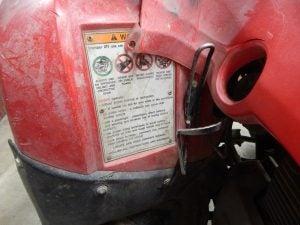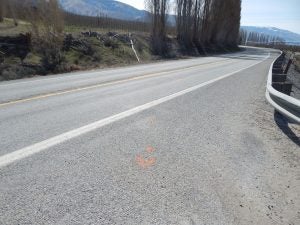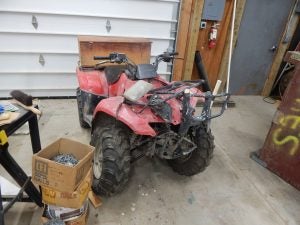Once used only for powersports and recreation, all-terrain vehicles have become a staple of modern agricultural operations, and these days few larger-scale farmers do without having at least one.
ATVs have proven their utility on farms in helping farmworkers gather livestock, pull trailers, and haul small loads and mobile equipment. Unfortunately, the increased agricultural use of ATVs has led to a rise in deadly crashes on farms. Time and time again we read or hear about a farmworker who was killed or seriously injured riding an ATV.
For the family and friends of a deceased worker, there are no words to describe the loss of a loved one.
Looking at Washington state alone, eight workers lost their lives in ATV crashes since 2013. Most worked on fruit and grain farms while one was a sheepherder. Five died after their ATVs were struck by vehicles on public roads.
When workers survive ATV crashes, the outcomes are often severe. During the same period, 106 workers in Washington were seriously injured in ATV incidents. While most were not injured on roadways and collisions, those who were suffered injuries that cost far more in medical and time loss expenses, nearly double on average, than those injured in non-roadway incidents.

The Occupational Safety and Health Administration reported that nationally from 2003 to 2013, there were 2,090 injuries and 321 fatalities in occupational ATV use, with 60 percent of deaths in agriculture.
The alarming numbers and devastating impacts of ATV crashes should galvanize farm employers to do everything possible in making sure ATVs are operated safely on farms.
A preventable tragedy
The Washington State Fatality Assessment and Control Evaluation (WA FACE) program at the Washington State Department of Labor & Industries has investigated numerous fatal ATV crashes. Most of them could have can be avoided by following the ATV manufacturer’s safety guidelines.
In a 2021 incident, a 40-year-old orchard worker was struck by a truck while riding an ATV on a state highway. The worker was using the ATV to deliver PVC pipe to an orchard where an irrigation line had to be repaired. He loaded both sides of the ATV with six to 12 pieces of 12-foot long, half-inch wide pipe. The pipe was sticking out of the front and back of the ATV, making it unstable and blocking the handlebars. He refused help from a co-worker riding with him on another ATV to take some of his load.
Heading to the orchard, the two workers drove on a gravel access road to an intersection with a paved state highway. The road had a slight downgrade where it met the highway. The worker with the pipe was leading. He tried turning right from the road onto the highway’s southbound shoulder but lost balance and control from the momentum and pipe blocking his steering ability. He rolled the ATV across the centerline into the northbound lane where an oncoming passenger truck going the 60 mph speed limit struck the ATV with the left front side of a horse trailer it was towing. The worker was thrown from the ATV onto the road. He died at the scene from severe head injuries.

Investigators found the worker lacked ATV training and did not follow the ATV manufacturer’s loading guidelines to use only the vehicle’s front and/or rear cargo racks. The worker also was not wearing a helmet and was riding the ATV on a highway against state traffic rules and the manufacturer’s safety guidelines to use the vehicle off-road only.
Safety tips for ATVs
Nothing can prevent every incident, but training and educating workers how to ride an ATV safely can make a life-ending crash less likely to happen. The following tips can help farmworkers avoid ATV crashes:
- Follow the manufacturer’s safety guidelines in the ATV owner’s manual. Safety guidelines specify age recommendations, helmet and other protective gear, passenger restrictions, maintenance standards, riding techniques, warning decal information, and cargo loading requirements. Make the guidelines accessible in a language that workers understand. Owner’s manuals usually come with newly purchased ATVs, but replacement copies can be obtained from vehicle dealers and online.
- Never ride an ATV on paved roads except to cross and where permitted by traffic laws. ATVs are made for off-road use and are not designed with handling and safety features for driving on paved roads. Riding an ATV on a paved public roadway greatly raises the risk of being struck by another motorist. Having visibly marked, designated off-road riding areas can also keep ATVs away from locations where a crash is more likely, such as steep slopes, deep ruts, and other obstacles.
- Do not ride an ATV unless trained and certified to use it. Many ATV crashes result from a lack of a training. Training should cover protective gear, pre-inspection, traffic laws, hazard identification, safe riding skills, loading and towing, and maintenance. ATVs are not “one size fits all,” so training should be given for each model farmworkers will use. It is also important for trainees to be familiarized with the terrain features and operating hazards of the designated off-road riding area. Hands-on training should take place in a safe, open, flat space. If possible, employers should enroll workers to take on-the-job ATV rider courses offered by the ATV Safety Institute.
- Develop a workplace safety and health program with a policy requiring ATV operators to follow manufacturer’s safety guidelines, traffic laws, and training. That should also include a job hazard analysis (JHA) requirement to identify workplace-specific ATV hazards and develop solutions to prevent them. Involving workers in the JHA can help build a farm safety culture that values everyone’s participation.
Preventing ATV hazards will ensure farmworkers go home each day safe and sound. Remember to ride safe so you can ride again.

This article was written by Paul Karolczyk, FACE research investigator, and Todd Schoonover, FACE program director. Sign up here to receive WA FACE agriculture fatality and injury investigation reports, hazard alerts, data summaries, and shorter form narratives and slideshows.


